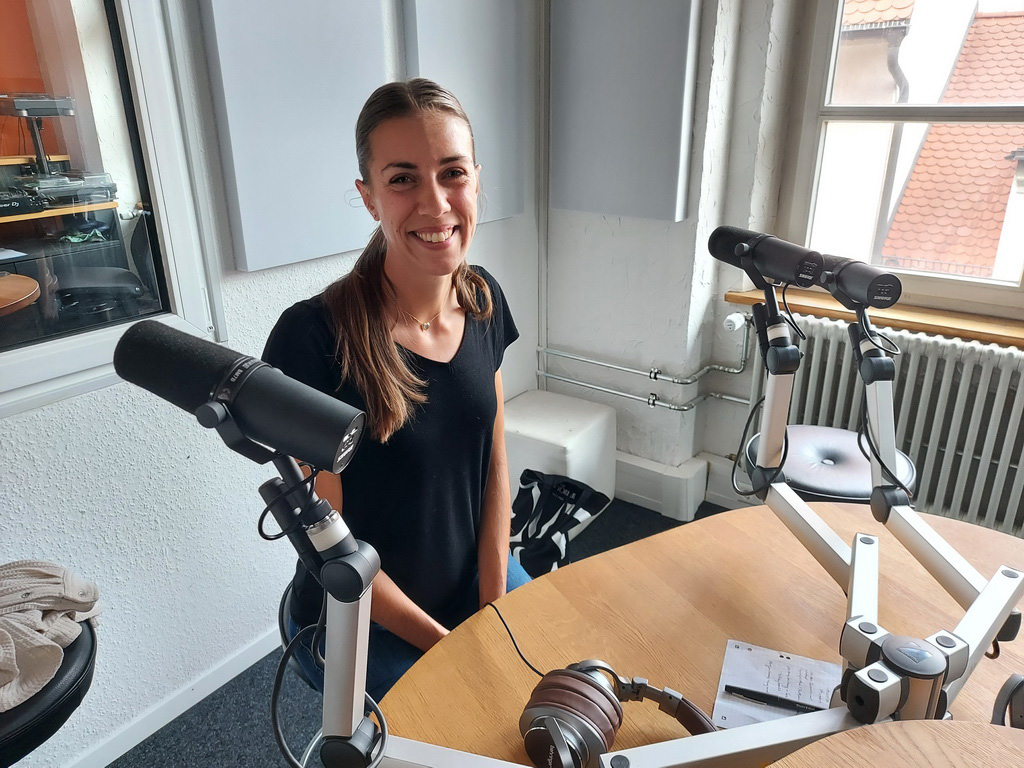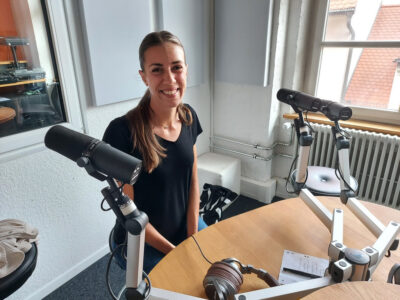Grüße aus Ulm!

Martha Balge at the Radio Free FM studio for her interview about the Hans Joohs Exchange.
Greetings from Ulm! Thank you to the Sister-Cities Commission of New Ulm for facilitating the Hans Joohs Exchange. I am about seven weeks into my 12-weeks stay in Ulm, Germany. Below is my first article, of three, for the New Ulm Journal about this wonderful experience.
It has been said that the early settlers of New Ulm, Minnesota, so named the city because of similarities they saw in the landscape to their homeland, the region around Ulm, Germany. I write from my host family’s home “on top of the hill” in Ulm, overlooking a valley similar to the one in New Ulm. At the bottom of Ulm’s river valley flows the Danube, a river that connects 10 countries in Europe.
On one of my bike rides in the region, I rode along a stretch of the river outside the city that felt similar to the Minnesota River near Minnecon Park, with trees close to the river’s edge and birds flying between trees and splashing in the river. In Ulm, as in New Ulm, I find there is a high quality of life when nature is so close to a bustling community.
Ulm is a city of 130,000 people, with the neighboring city of Neu-Ulm adding 62,000 to the area. Neu-Ulm is a city separate from Ulm, with the Danube as a border between them. The Danube also marks the border between two Bundesländer, or states. Ulm lies in Baden-Württemberg; Neu-Ulm in Bavaria.
Today, these German twin cities look different from their American namesake. In comparison to the houses in New Ulm, many of the houses in Ulm/Neu-Ulm are of white stucco, often with red roofs. Behind many houses are small paths with hedges on both sides. These footpaths connect streets and offer a quick route to a local soccer field or clubhouse. They provide a quiet, safe, and pretty walk away from the bustle of the street.
An efficient bus and tram system connects the city and makes getting around very easy. I use the transportation system almost every day to get to the Innenstadt, or downtown. At the center of the Innenstadt rises the Münster, the tallest Christian church in the world. Not far from the Münster is the beautifully painted Rathaus, or city hall, rebuilt after much of the old downtown was destroyed in World War II.
Beyond these recognizable sites wind cobblestone alleyways, lined with restaurants and cafes. During the summer, people sit at tables outside, enjoying their meals or simply a coffee. Twisting through the old streets is a small river, the Blau, which flows into the Danube. Picturesque bridges connect the cobblestone streets and lampposts add a soft glow to the warm summer evenings I’ve experienced in the city.
Ulm has a deep history of international connections. The phrase “Ulmer Geld regiert die Welt” or “Ulm money rules the world” refers to a time in the Middle Ages, when Ulm minted money and was connected to the European trade network.
Today, businesses that operate around the world still thrive in Ulm. Several members of the Ulm Rotary Club graciously invited me to visit their businesses. Seeberger, an international company that produces snack mixes, nuts, and coffee, was founded in the Innenstadt of Ulm and still packages its products in Ulm today. Peri, a company that designs and produces scaffolding and equipment for construction, operates just outside of Ulm. Its materials have been used, for example, on the Panama Canal and to build a bridge/tunnel between China and Hong Kong.
The international connections of Ulm extend to the people living in Ulm. Ulm is home to many immigrants, many of whom have arrived in the last decade. Many of the children at the grade schools I visited in the area speak or are learning German as a second language.
The people of Ulm have made my experience with the Hans Joohs Exchange memorable. I am very grateful to the Rotary Club of Ulm for their hospitality. Through the Rotary Club, I am being housed by the wonderful Janni family for the extent of my stay, 12 weeks. Staying with such a lovely German host family has made this experience particularly special.
As mentioned above, several Rotary Club members have invited me to visit their businesses, experiences which, to me, were simply fascinating. Others have invited me to meals at their homes and to trips in and around Ulm. Opportunities like this, to engage in conversation with Germans from our sister city, highlight for me what an incredible program – what a true exchange — the Hans Joohs Exchange is.
In the past few weeks I met German participants of the Hans Joohs Exchange. Annika Fischer, who went from Neu-Ulm to New Ulm last year, invited me to run in a Frauenlauf, a fun-filled race for women in downtown Ulm. Samuel Knoops, who will go to New Ulm in September, gave me a tour of Gold Ochsen, where he is a brewer. He will be doing an internship at Schell’s during his time in New Ulm.
It was pleasant to talk with both of them about our experiences, and what to expect, in our sister-cities.
About half-way through my time here, I took part in another conversation, in the form of a radio interview. For about an hour I was interviewed live, in German, by a local radio station, Radio Free FM. During this interview, I spoke about my hometown New Ulm, my experiences in Ulm, and about the Hans Joohs Exchange.
The Hans Joohs Exchange has been sending young people across the Atlantic since 1988. Thank you, New Ulm, for your support of this opportunity to experience life in our sister-city, Ulm!
Bis zum nächsten Mal, till next time.
— Martha Balge

